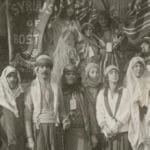[- A Journey Through Time: Unraveling the History of Armenia-] Dive into the captivating narrative of Armenia, a nation steeped in ancient lore and resilience. From the mystifying origins of its civilization to the tumultuous struggle for Nagorno-Karabakh, from the arrival of Timur Lenk to the Ottoman and Persian dominations, from the Kingdom of Cilicia to the twilight of Armenian independence, this exploration delves into the heart of a people and their enduring spirit.
Key Takeaways:
-
The early presence of humans in Armenia is evidenced by stone tools dating back 325,000 years.
-
Excavations in the Yerevan 1 Cave revealed a 48,000-year-old heart, a human cranial fragment, and a tooth of similar age, indicating ancient human habitation.
-
Traces of settlement in the Armenian Highland date back to the Neolithic era.
-
The Byzantine Emperor Maurice defeated the Persians in 591, leading to the establishment of the Armenian principality of Taron.
-
The Ottoman Empire committed the Armenian genocide in 1915, resulting in the deaths of over a million Armenians.
-
Armenia gained independence from the Soviet Union on 23 August 1990, confirmed by referendum in September 1991.
History of Armenia

Greetings, history enthusiasts! Join me on a captivating journey through the annals of Armenia’s rich and storied past. As a historian with a passion for unearthing forgotten tales, I’m thrilled to share Armenia’s remarkable story, a tapestry woven with ancient civilizations, fierce battles, and cultural triumphs.
Armenian Roots: The Dawn of Civilization
Armenia’s history begins in the mists of time. Archaeological discoveries reveal that early humans roamed this land over 300,000 years ago, leaving behind stone tools as evidence of their presence.
The Neolithic era witnessed the emergence of settlements in the Armenian Highland, as people began to cultivate crops and domesticate animals. These early communities laid the foundation for the vibrant civilizations that would flourish in the centuries to come.
Caught in the Crossfire: Armenia’s Struggle for Independence
Throughout history, Armenia’s strategic location at the crossroads of empires has often made it a battleground for powerful forces. From the Persians to the Byzantines and Ottomans, various empires have sought to control this land, leaving an indelible mark on its history.
One of the most tragic chapters in Armenia’s history is the Armenian genocide, a systematic campaign of extermination carried out by the Ottoman Empire during World War I. Over 1 million Armenians perished in this horrific event, leaving a deep scar on the nation’s collective memory.
A New Dawn: Armenia’s Independence and Beyond
The 20th century brought both great challenges and triumphs for Armenia. After enduring decades of Soviet rule, Armenia declared independence in 1991, embarking on a new era of self-determination.
Today, Armenia stands as a proud and independent nation, striving to build a brighter future while preserving its rich cultural heritage. Its ancient churches and monasteries, stunning landscapes, and vibrant traditions continue to attract visitors from around the world.
Thank you for joining me on this historical odyssey through Armenia. This is just a glimpse into the captivating narrative of this ancient land. Delve deeper into its history, and you’ll discover a treasure trove of stories, legends, and achievements that have shaped the world we live in today.
Learn everything you ever wanted to know about the cultural and political history of Armenia and Azerbaijan.
THE ARRIVAL OF TIMUR LENK AND THE OTTOMAN AND PERSIAN DOMINATION

In the unfolding tapestry of Armenian history, few chapters are as turbulent and transformative as the era marked by the arrival of Timur Lenk, and the subsequent dominance of the Ottoman and Persian empires. This period, characterized by relentless warfare, shifting alliances, and profound cultural and political shifts, left an indelible imprint on the Armenian people and their ancestral lands.
Key Takeaways:
-
Timur’s Invasion:
- In 1386, Timur Lenk, a fearsome conqueror from Central Asia, embarked on a campaign of conquest that would leave a trail of destruction across Armenia.
- His forces sacked cities, massacred civilians, and reduced once-prosperous regions to smoldering ruins.
- The Armenian people suffered greatly under Timur’s brutal rule, their lives and livelihoods shattered by the relentless onslaught.
-
Ottoman and Persian Dominance:
- Following Timur’s death in 1405, Armenia became a battleground between the Ottoman and Persian empires, each vying for control of this strategically important region.
- The Ottomans emerged victorious, establishing their rule over much of Armenia in the early 16th century.
- Ottoman rule was often oppressive, with heavy taxation, forced conversions to Islam, and restrictions on Armenian cultural and religious practices.
-
Cultural Resilience:
- Despite centuries of foreign domination, the Armenian people clung steadfastly to their identity, preserving their language, religion, and cultural heritage.
- Armenian churches, monasteries, and manuscripts became sanctuaries of cultural preservation, keeping the flame of Armenian identity alive during dark times.
-
The 19th Century:
- The 19th century witnessed a resurgence of Armenian nationalism and aspirations for independence.
- This period was marked by increased cultural and political activity, as well as Armenian involvement in revolutionary movements against Ottoman rule.
-
The Armenian Genocide:
- The darkest chapter in Armenian history unfolded during World War I, when the Ottoman Empire systematically exterminated over 1 million Armenians in the Armenian Genocide.
- This horrific event stands as a stark reminder of the fragility of peace and the enduring legacy of ethnic hatred.
Relevant URL Sources:
THE KINGDOM OF CILICIA AND THE END OF ARMENIAN INDEPENDENCE
Enter the fascinating world of the Armenian Kingdom of Cilicia, a refuge for Armenian refugees fleeing the Seljuk invasion in the 11th century. Nestled in the Cilicia region northwest of the Gulf of Alexandretta, this haven served as a testament to the resilience and adaptability of the Armenian people.
Key Takeaways:
-
Tigranes the Great’s Expansion: Under his rule, Armenia expanded its territory, conquering vast regions in the Levant, including Cilicia. The Armenian presence in Cilicia dates back to this period.
-
Rise of the Het’umids: The Het’umids settled in western Cilicia in the 11th century, establishing a dynasty that lasted over two centuries. Their reign shaped the fate of Cilician Armenia.
-
Diverse Society: Cilician Armenia boasted a diverse population, with Armenians forming the ruling class and other ethnic groups, including Greeks and Armenians, contributing to the region’s rich cultural tapestry.
-
Emergence of the Armenian Kingdom: Fleeing the Seljuk invasion, Armenian refugees settled in Cilicia and united to form the Armenian Principality of Cilicia, laying the foundation for the future kingdom.
-
Decline and Fall with the Lusignan Dynasty: The Lusignans forged ties with the Armenians through marriage and political alliances. However, this alliance ultimately contributed to the decline of the Armenian Kingdom of Cilicia.
Significant Events in the Kingdom of Cilicia:
-
1198: King Leo II of Armenia established diplomatic relations with the Holy Roman Empire.
-
1221: Cilician Armenia signed the Treaty of Antioch with the Seljuk Sultanate of Rum.
-
1243: The Mongols launched an invasion of Cilicia, weakening the kingdom.
-
1375: The Mamluks of Egypt conquered and destroyed Sis, the capital of Cilician Armenia.
Sources:
1. Armenian Kingdom of Cilicia – Wikipedia
2. The Armenian Kingdom of Cilicia















